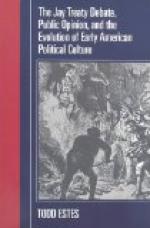|
This section contains 1,924 words (approx. 7 pages at 300 words per page) |

|
Analyzing Jay's Treaty
Summary: Dissects the 1795 treaty between the United States and Great Britain, Jay's Treaty. Examines complaints about the treaty. Concludes that the Treaty was not as bad as the propaganda made it out to be.
In the mid-1790s, the United States had a substantial list of grievances against the country of Great Britain, all of which needed to be resolved. United States President George Washington sent Supreme Court Justice John Jay to London in order to negotiate the treaty which came to be known in the United States as "Jay's Treaty." Though the specific orders from Washington to Jay are still not clear, many of the United States' grievances were resolved as well as possible. American complaints included, but were not limited to, partial trading policies, British imprisonment of American seamen, and failure of British compliance to previous agreements. The American government received the finalized treaty with outrage because not all of their demands were touched upon. Additionally, many Americans opposed the treaty before negotiations between Jay and the British representative, William Wyndham Baron Grenville, had commenced because Jay was seen as...
|
This section contains 1,924 words (approx. 7 pages at 300 words per page) |

|


